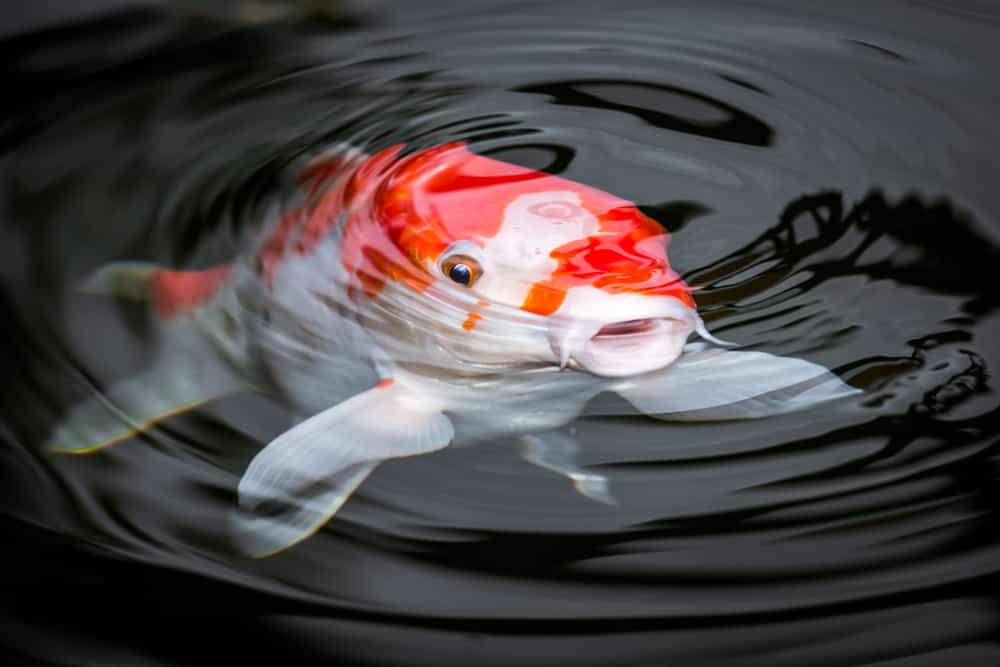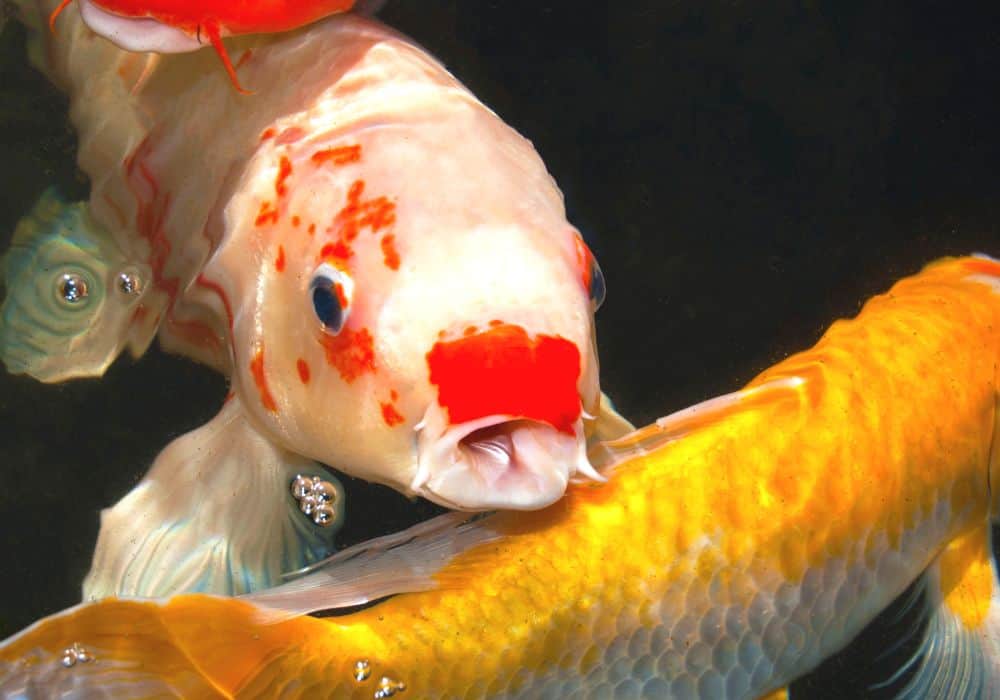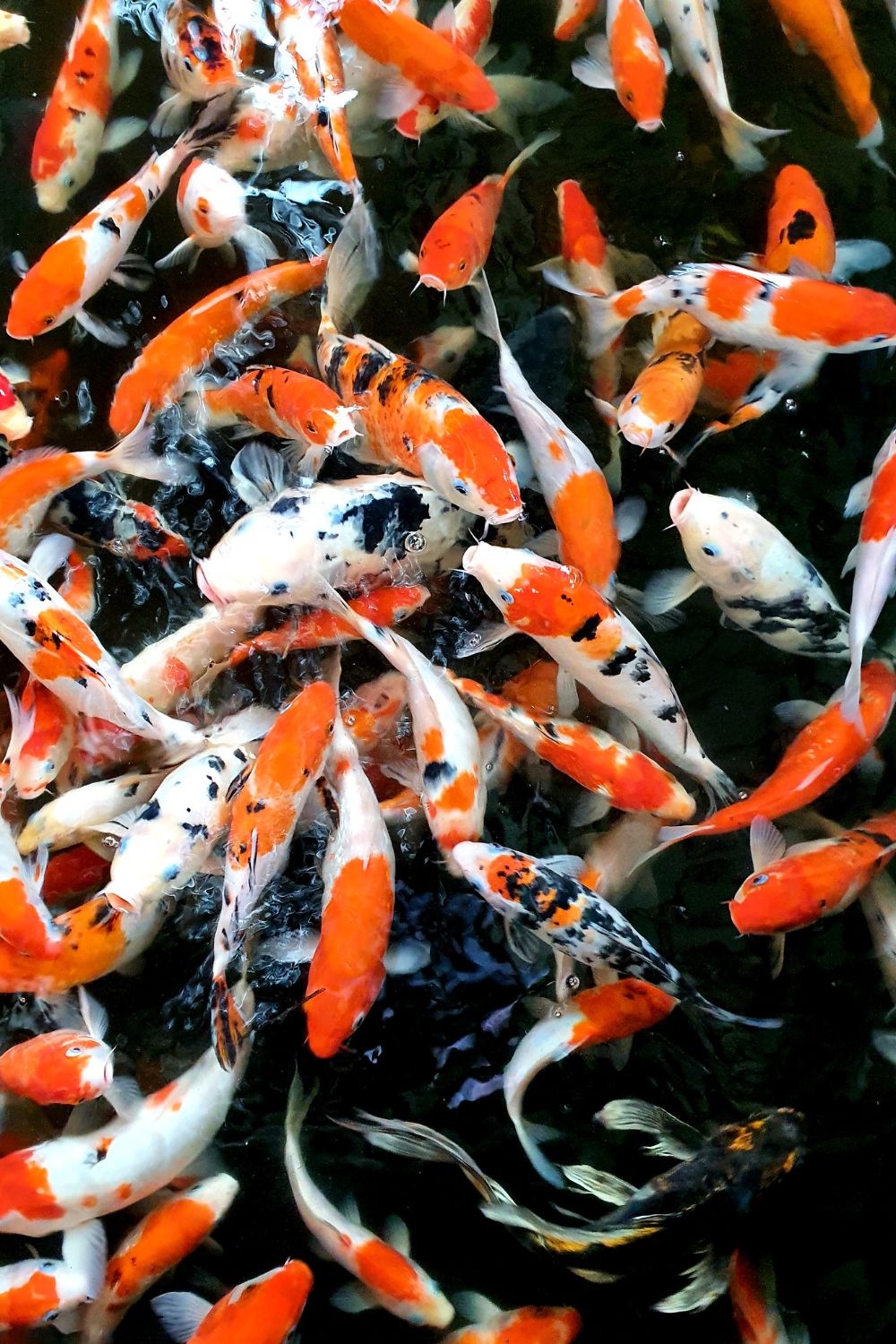Koi is one of the most beautiful species out there, and providing them with a good and well-balanced diet is one of the most important things you can do to guarantee their thriving in your outdoor pond or indoor tank.
In this article, we’ll tell you everything you need to know about feeding koi fish, including what and how to feed them. If you’re interested in learning this and much more, you came to the right place!
Facts About Koi Fish
What’s called koi fish is actually selectively bred specimens of the Amur carp (Cyprinus rubrofuscus). The breeding originated in 19th century Japan and since has taken over the world, making koi fish one of the most sought-after pond fish species.
Some people keep koi fish at home in huge aquariums, but most koi keepers raise them in outdoor ponds, usually in gardens, where koi fish add a special element of design that cannot be replicated by anything else.
As koi are praised for their beauty, it’s only natural that there are dozens of varieties, each carrying its own unique features and characteristics.
For example, a variety called kōhaku (“red-white”) features white skin and huge red marks along the spine, while a variety called utsurimono (reflections) can have skin that’s either white, red, or yellow, adorned with black markings in a zebra pattern.
What Do Koi Fish Eat?
Koi fish are omnivores that eat pretty much everything they find, including both, plant-based and animal-based foods, ranging from algae, hyacinths, and water lettuce, to various types of larvae, species of crustaceans, worms, and even other fish!
Because they’re opportunistic feeders capable of digesting most types of food, their diet is really varied in the wild, and it can seem to be difficult to replicate by yourself.
However, that’s the opposite, a wide selection of food options makes it easy to fun to properly feed your koi. Let’s go through all the options one by one, so you can understand when and which option to choose to guarantee the health and longevity of your fish.
Fish Pellets
This option is the easiest for you because it includes everything your koi needs to be happy, including a good ratio of protein, fat, and carbohydrates. Your koi will be healthy if you just feed them fish pellets and don’t supplement the diet with other food options.
However, keep in mind that you must buy fish pellets that were specifically designed for koi. Pellets made for other fish species will have a different nutritional profile, which might hurt your koi fish in the long term.
In the pinch, you can opt-in for pellets marketed for feeding goldfish. After all, both koi fish and goldfish are carps and are very similar biologically. That being said, pellets for goldfish usually consist of more carbohydrates and less protein, which isn’t ideal for koi.
Another thing to consider is that most fish pellets sink, meaning they will sink to the bottom of the pond if your koi don’t eat them in time. As a result, fish pellets can affect the water quality, causing health problems to your fish. Fortunately, there are some brands of fish pellets that don’t sink, but rather float, making it easy to scoop them out before they dissolve.
Finally, if you own a juvenile fish, pellets might be too big for them to feed on, so you might want to opt in for other options that are easier to swallow, and start using fish pellets on mature koi fish.
All in all, fish pellets are the #1 most recommended food option for older koi fish. Most koi owners use pellets as the very basis of the diet, only supplementing it with other options once in a while. It’s simply too convenient and affordable to use something else.
Fish Flakes
Another great option comes with everything you need to include in your koi fish diet. That being said, fish flakes are almost always inferior to fish pellets in nutritional profile, coming with fewer vitamins and minerals.
That’s if we’re comparing products at a similar price point, so there are fish flakes that are better even than the pellets. However, just like with the pellets, keep in mind that you have to buy those that are specifically advertised for feeding koi.
The biggest downside of fish flakes is that they start decomposing quickly after coming into contact with the water. If your koi don’t eat it in time, flakes will disintegrate and lower the quality of your pond or aquarium.
There’s also one clear advantage of fish flakes – their size. Young koi fish aren’t big enough to eat fish pellets, so fish flakes become the best option to base the koi’s diet around until it becomes big enough to swallow fish pellets.
Freeze-Dried
In the wild, koi fish eat a variety of animals and insects. The great thing is that you can get them freeze-dried and feed them to your domestic koi! Many online and brick-and-mortar pet stores have at least some freeze-dried options suitable for koi fish, like:
Freeze-dried food is made by freezing the animals, and then placing them in a vacuum chamber, which quickly draws out the moisture from the inside, turning ice crystals into water vapor.
It preserves most of the nutrients in the food and prevents it from going stale for years on end. Some of the freeze-dried food comes additionally processed, like ground up and formed into cubes. Bigger animals, like krill, can come whole.
Despite numerous advantages over fish pellets and flakes, freeze-dried foods should only be used as an occasional treat. First of all, it’s just more expensive compared to those options.
More importantly, you need to have a lot of knowledge of koi fish to be capable of building an entire diet just from freeze-dried food items. Each freeze-dried food comes with a different nutritional profile, with different ratios of major nutrients.
As a result, it’s really difficult to come up with a balanced koi fish diet consisting entirely of freeze-dried foods.
Frozen Food
Another option to supplement your koi fish diet with additional minerals and vitamins is frozen food. Just like freeze-dried, it has a long shelf life and includes many different options. However, you got to thaw it before feeding it to your koi.
Never throw solid frozen food into your pond or aquarium, as it can upset your fish. To thaw frozen food, most people leave it sitting in the fridge over the night, but if you find such an option unpleasant, you can leave it in a bowl of cold water for 30-60 minutes.
Live Food
If you want to simulate the natural environment of koi fish, you can feed them live foods that they find in the wild. The biggest advantage of this option is nutrition because live food always contains more nutrients than freeze-dried or frozen options.
Additionally, koi fish are used to hunt their prey and feeding them alive animals can offer your fish a great deal of entertainment. However, there are many downsides. First of all, you have to maintain the food alive until you feed it to your fish.
That has its own costs and can take up more time than taking care of koi itself. Then, there’s always a risk of getting live food that carries diseases or parasites. Your fish can get sick by ingesting such food.
As a result, most koi keepers use live food just once in a while or build entire self-sustaining ecosystems that imitate the wild environment of koi fish, where various animal and plant species interact and sustain themselves.
Vegetables and Fruit
As mentioned, koi fish are omnivorous, meaning they eat both, animal and plant foods. That’s why you can feed them vegetables including broccoli, cauliflower, garlic, lettuce, and even fruit, including lemons, oranges, grapes, strawberries, and watermelon.
That’s one of the most surprising fish food options to many people, but offers plenty of nutrients to your fish, specifically vitamin C which koi usually lack.
Finally, while not precisely a vegetable, wheat germs are a great option to use during winters, when the water temperature drops and koi spend more time deeper in the pond.
How Often and How Much Do They Eat?
The feeding schedule and the amount of food your koi require depend on water temperature and the season of the year. Here are general guidelines for that:
- Water Temperature Between 41˚F and 65˚F (5˚C to 18˚C – Feed Every Other Day
- Between 66˚F and 80˚F (18˚C to 27˚C) – Feed Every Day
With every feeding, you should give them food equal to anything from 1% to 4% of their body weight. Obviously, not many owners know how much their fish weighs, so they resort to feeding koi for 3-5 minutes, slowly introducing food into the water bite bite bite.
How to Feed Koi Fish?
Feeding koi fish is easy, just prepare the food in bite-size pieces so your fish can eat them in one gulp. Some owners even feed their fish straight out of their hands, by taking some food and submerging their hands in the water.
Here are some additional do and don’ts for properly feeding your koi fish:
- Do remove uneaten food from the water, because it starts decomposing, releasing ammonia
- Don’t feed carb-heavy foods like bread, corn, and peas, because koi fish can’t properly digest it
- Don’t use wild animals you caught in the wild for feeding your koi
- Don’t feed koi when the water temperature is below 40˚F (5˚C)
- Do feed more protein to koi fish until it reaches 3 years of age
Final Words
It is important to know what koi fish eat so that you can provide them with a balanced. We hope this article helped you understand the ins and outs of that, so we wish you all the best in your fishkeeping journey!


